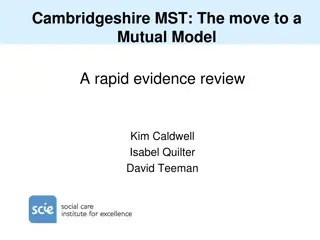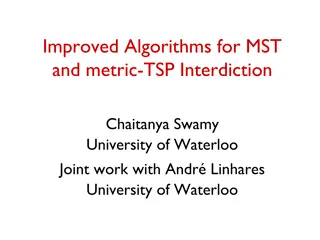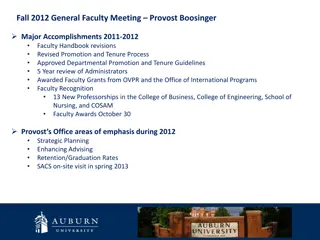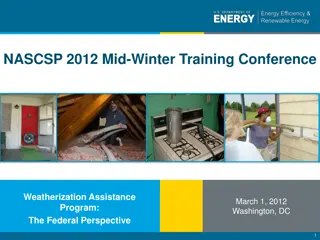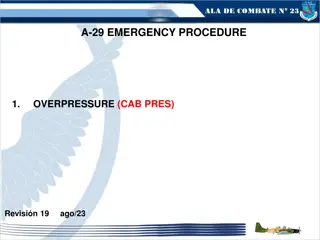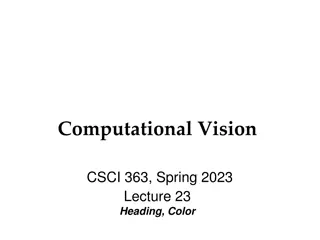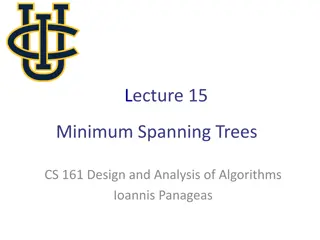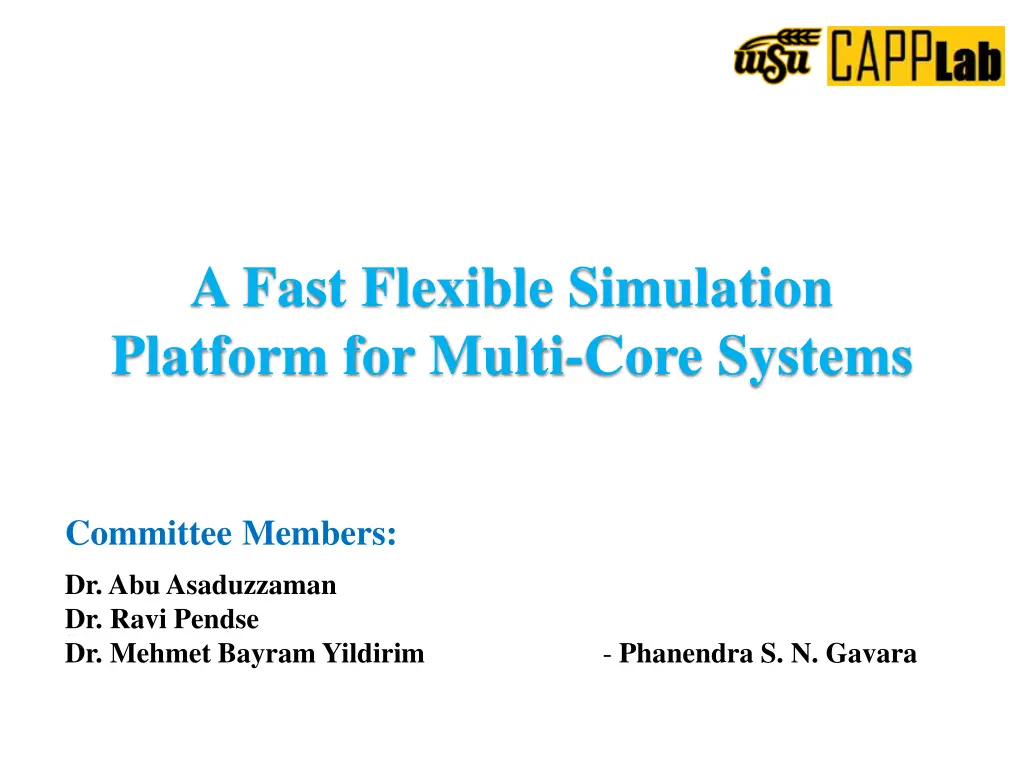
Fast Flexible Simulation Platform for Multi-Core Systems & Their Evaluation
Develop a simulation platform for multi-core systems to address power consumption and high performance, with contributions including top-level analysis for performance and power, suited for future complex architectures. Evaluation techniques from international symposia on computer architecture are employed for rigorous assessment. Simulation techniques are compared to measurement and analytical methods, highlighting the benefits of simulation for design analysis and scalability.
Download Presentation

Please find below an Image/Link to download the presentation.
The content on the website is provided AS IS for your information and personal use only. It may not be sold, licensed, or shared on other websites without obtaining consent from the author. If you encounter any issues during the download, it is possible that the publisher has removed the file from their server.
You are allowed to download the files provided on this website for personal or commercial use, subject to the condition that they are used lawfully. All files are the property of their respective owners.
The content on the website is provided AS IS for your information and personal use only. It may not be sold, licensed, or shared on other websites without obtaining consent from the author.
E N D
Presentation Transcript
A Fast Flexible Simulation Platform for Multi-Core Systems Committee Members: Dr. Abu Asaduzzaman Dr. Ravi Pendse Dr. Mehmet Bayram Yildirim - Phanendra S. N. Gavara
Outline Problem description Thesis contributions Why simulation technique? Brief introduction to multicore processors Proposed simulation tool Evaluation Conclusions Future work
Problem Description Multicore systems are now a days mainly method against the power consumption and high-performance Design and research on such physical systems are confined to research industries: Intel Polaris- 80 Core Terascale Chip, 80 cores[1] IBM BladeCenter System-QS22/LS21 has 122,400 cores[2] There is no suitable software/firmware that meets our research needs in multicore systems [1] http://software.intel.com/en-us/articles/developing-for-terascale-on-a-chip-first-article-in-the- series/?wapkw=Teraflop%20Research%20Chip [2] http://www-05.ibm.com/fr/events/campus_paris/Francois_Thomas.pdf
Problem DescriptionCont Any few traces found are specific to their own design and imposes copy right issues Hence there is a need for flexible simulation platform which is: Suitable to model any multicore system Flexible to perform the top level pre-design analysis Can be used for the future complex architectures
Thesis Contributions Develop a fast flexible simulation platform for multicore systems Using the platform, implement a serial/parallel processing system for the top level analysis of performance and power Analyze the sequential and parallel executions of the target workloads
Evaluation Techniques Performance evaluation methodologies in proceedings of the international symposium on computer architecture J.J. Yi, L. Eeckhout, D.J. Lilja, B. Calder, L.K. John, and J.E. Smith. The Future of Simulation: A Field of Dreams? The IEEE Computer Society, pages 22-29,2006.
Why Simulation Technique? Measurement Analytical Simulation 1. 2. 3. 4. Physical system Cost involved Not Flexible Not Scalable 1. 2. 3. 4. Not required Less cost Not Flexible Scalable 1. 2. 3. 4. Not required Less cost Flexible Scalable Direct measurement is a post-design step and not useful for systems under design. Analytical method is good for preliminary design but not suitable for assessing detailed design trade-offs and complex systems.
Current Research & Tools MIT Hornet - Targeted for cycle accurate simulation for up to 1000 Cores Graphite Multicore Simulator - Deep level analysis FastMP - Aimed at speeding up multi-core simulation runtimes VirtualSim SimuLink MicroSaint etc.
A Multicore Processor In which, cores are integrated onto a single circuit known as a Chip Multicore processor. Composed of two or more independent cores (or CPUs) typically up to 32 [1]. A Manycore Processor Cores are large in number, likely requires a Network-on- Chip architecture. Threshold is up to hundreds and several thousands of cores [1] Many-core processor, 2008. http://software.intel.com/en-us/articles/many-core-processor/
Current & Future Market Current publicly available multicore processors have 2 to 4 cores [i.e. Amd x2 and x4 series, Intel i7 (8 threads)] Future we will see up to hundreds and several thousands of cores for the commercial purpose like Could Services , Heavy Virtualization, Super Computers etc. http://ark.intel.com/products/63698/Intel-Core-i7-3820-Processor-%2810M-Cache-3_60-GHz%29
Dual Core Chip The two cores are two separate processors plugged into the same socket Theoretically twice as powerful as a single core processor. Performance gains are said to be about fifty percent: Therefore one-and-a-half times as powerful as a single core processor. http://www.xda-developers.com/android/first-htc-sensation-rom-with-enabled-full-dual-core-support/
Multicore Chip Core 1 Core 2 Core 3 Core 4 http://www.teknocrat.com/core-vs-cpu-socket-chip-processor-difference-comparison.html
Threads Running Concurrently (in Parallel) Threads Threads Threads [1] Core 1 Core 2 Core 3 [1] http://groups.csail.mit.edu/carbon/?page_id=111
Threads Assignment http://home.dei.polimi.it/gpalermo/doc/PIN.pdf
PROPOSED SIMULATION TOOL
Design Goals Multi-Core Simulation Platform Add additional Functionality (Optional) Applications Synthetic Workloads Preprocessing Tools Results/ Analysis
Serial/Parallel Processing N Cores I1, D1 Cache L2 Cache Interval Input Independent/Parallel workloads Dependent/Serial workloads Output Total Processing Time Total Power FCFS (First Come, First Serve) System Provision for Arrival time and Priority
Workloads In computer industry, a workload is the real task done by the CPU Synthetic workloads are the abstraction of real workload In multicore, workloads are characterized into: Serial/Dependent Parallel/Independent
Serial Workload Job_Num Num_of_Threads Thread_Duration (Units) Arrival_Time (Units) Priority 0001 002 003 0.00 1 0001 003 004 0.00 1 Same job could have different thread types Each job could be real-time application Each applications is divided into multiple threads
Parallel Workload Job_Num Num_of_Threads Thread_Duration (Units) Arrival_Time (Units) Priority 0001 002 002 0.00 1 0002 008 001 0.00 1 0003 002 002 0.00 1 0004 004 001 0.00 1 0005 001 007 0.00 1 Each job could be real-time application Each applications is divided into multiple threads
Raw Workload Num_of_Threads Thread_Duration (Units) Arrival_Time (Units) Priority Job_Num 002 002 0.00 1 0001 008 001 0.00 1 0002 003 003 0.00 1 0003 004 001 0.00 1 0003 009 001 0.00 1 0004 006 003 0.00 1 0005 002 003 0.00 1 0006 004 006 0.00 1 0006 Each job could be real-time application Duplicate jobs are interdependent
Flowchart of Executions Start User Inputs: Number of Cores, Interval, Mode, Input and Output File Name Initialization: Processor, Cores & other Parameters like Job, Queue etc. CP-1 Process the Input file into Sequential & Parallel workload files Parallel Serial Mode P/S? B A
Serial Execution A CP-2 Compute the total number of threads and delays associated with each job and write the new jobs to a Serial_to_Prallel workload file. Append the jobs of Serial_to_Prallel file to the Parallel _Input filefor the analysis of total processing time and power in a multi-core environment. C
P A R A L L E L B CP-3 C Based on the Multicore System, jobs are loaded from the Parallel _Input file to the Input_Queue Threads are distributed among the available free cores, Interval timeris set and the Avl_Free_Cores are updated Allocate/Busy Allocate/Busy Allocate/Busy Allocate/Busy Core 2 Core N-1 Core N Core 1 Thread_Durations are updated with the Interval duration and Cores are set free accordingly E X E C U T I O N Core 2 Core N-1 Core 1 Core N De-allocate/Free De-allocate/Free De-allocate/Free De-allocate/Free Parameters like Upd_Free_Cores, Processing_Time, Power_Cnsmptn are updated and logged to a file called Results Yes Load Jobs? B CP-4 No Total Processing_Time & Power_Cnsmptn are computed and written to an output file Stop
Code Struct processor{ unsigned int num_of_cores; typeCore processor_core[]; unsigned int cl2_size; }; typedef struct processor typeProcessor; Struct Core{ unsigned int i1_size; unsigned int d1_size; unsigned int flag;//0 for free, 1 for empty }; typedef struct Core typeCore;
Parallel workload on a 16 Core System Job_Num Num_of_Threads Thread_Duration (Units) Arrival_Time (Units) Priority 0001 0002 0003 0004 0005 0006 0007 0008 0009 0010 002 008 003 004 002 009 006 002 004 005 002 001 003 001 008 001 003 003 006 005 0.00 0.00 0.00 0.00 0.00 0.00 0.00 0.00 0.00 0.00 1 1 1 1 1 1 1 1 1 1
Parallel workload on a 32 Core System Job_Num Num_of_Threads Thread_Duration (Units) Arrival_Time (Units) Priority 0001 0002 0003 0004 0005 0006 0007 0008 0009 0010 002 008 003 004 002 009 006 002 004 005 002 001 003 001 008 001 003 003 006 005 0.00 0.00 0.00 0.00 0.00 0.00 0.00 0.00 0.00 0.00 1 1 1 1 1 1 1 1 1 1
Checkpoint Evaluation Total Processing Time Serial Workload Total Power Raw Input Parallel Workload Checkpoint-1 I O1 O2 - - Check Point-2 - I O3 - - Check Point-3 - - O3+O2 - - Check Point-4 - - I
Checkpoint-1: Raw workloads Serial/Dependent (O1) & Parallel/Independent (O2) workload files Checkpoint-2: Output of Checkpoint-1 (O1) Parallel/Independent (O3) Checkpoint-3: Output of checkpoint-2 (O3) Parallel/Independent (O2+O3) Checkpoint-4: Output of checkpoint-3 (O2+O3) Evaluate total processing time and power
Logic Based Distributed Routing Architecture Core 1(0,0) wants to communicate with Core 15(1,6) Path taken: (0,0), (0,0). (1,0). (1,4), (1,6) Abstraction of actual work to Synthetic Workload Job_Num Num_of_Threads Thread_Duration 0001 002 002 0001 003 001 Rodrigo, S.; Medardoni, S.; Flich, J.; Bertozzi, D.; Duato, J.; Efficient implementation of distributed routing algorithms for NoCs Computers & Digital Techniques, IET Volume: 3, Issue: 5, DOI: 10.1049/iet-cdt.2008.0092, page(s): 460-475.2009.
[Chaturvedula, 2011] Proposed Architecture Solid nodes Switching Nodes Empty nodes Computing Nodes Striped node Switching & Computing Node Chaturvedula, R.; Designing Multi-Core Architecture Using Folded Torus Concept to Minimize the Number of Switches , Thesis in Masters of Science, Florida Atlantic Wichita State University, Dec, 2011.
Communication paths for LBDR and [Chaturvedula, 2011] Proposed Architectures in the case of 16 Core [Chaturvedula,2011] Model Source-Destination LBDR Case 1 Node 2 Node 15 2, 1(Sw), 6(Sw), 11(Sw), 15 2, 1(Sw), 13(Sw) , 15 Case 2 Node 3- Node 14 3, 1(Sw), 6(Sw), 11(Sw), 14 3, 1(Sw), 13(Sw), 14 Case 3 Node 7 Node 15 7, 6(Sw), 11(Sw), 15 7, 11(Sw), 15 Case 4 Node 2 Node 10 2, 1(Sw), 6(Sw), 10(Sw) 2, 6(Sw), 10 Chaturvedula, R.; Designing Multi-Core Architecture Using Folded Torus Concept to Minimize the Number of Switches , Thesis in Masters of Science, Florida Atlantic Wichita State University, Dec, 2011.
Derived workloads for LBDR Model Job_Num 0001 0001 0002 0002 0003 0003 0004 0004 Num_of_Threads 002 003 002 003 002 002 002 002 Thread_Duration (Sec) Arrival_Time Priority 002 001 002 001 002 001 002 001 0.00 0.00 0.00 0.00 0.00 0.00 0.00 0.00 1 1 1 1 1 1 1 1 Derived workloads for [Chaturvedula, 2011] Model Job_Num Num_of_Threads Thread_Duration (Sec) Arrival_Time Priority 0001 002 002 0.00 1 0001 002 001 0.00 1 0002 002 002 0.00 1 0002 002 001 0.00 1 0003 002 002 0.00 1 0003 001 001 0.00 1 0004 002 002 0.00 1 0004 002 001 0.00 1
Delay analysis for 16 nodes 8 7 6 Delay (Units) 5 LBDR 4 Simulation 3 2 1 Case 1 Case 2 Case 3 Case 4 LBDR and Simulation results are very similar
Delay analysis for 16 nodes 7 6 5 Delay (Units) [Chaturvedula, 2011] Model Simulation 4 3 2 1 Case 1 Case 2 Case 3 Case 4 [Chaturvedula, 2011] and Simulation results are very similar
Parallel Workload Job_Num Num_of_Threads Thread_Duration Arrival_Time Priority 0001 0002 0003 0004 0005 0006 0007 0008 0009 0010 0011 0012 0013 0014 0015 002 008 007 004 004 007 003 015 004 005 010 001 007 002 015 020 006 018 010 028 009 001 025 005 005 007 060 028 041 001 0.00 0.00 0.00 0.00 0.00 0.00 0.00 0.00 0.00 0.00 0.00 0.00 0.00 0.00 0.00 1 1 1 1 1 1 1 1 1 1 1 1 1 1 1
Total Processing Time Analysis Total processing time for various core systems 160 Load Interval = 1 Unit Total Processing Time (Units) 140 120 100 80 Duration 60 40 20 0 16 Core 32 Core 64 Core 128 Core 160 Core 192 Core High performance results in128 core system
Total Power Analysis Total Power Analysis 800 ASSUMPTIONS: Core Busy = 0.1 Unit Core Idle = 0.05 Unit Core Off = 0 Unit 700 600 Total Power (Units) 500 On/Off 400 On/Idle/Off 300 200 100 0 Core 16 Core 32 Core 64 Core 128 Core 160 Core 192 On/Off condition results in constant power utilization On/Idle/Off condition results in increased power utilization with the increase in number of cores
Overall Observations 128 core system results in high performance, but with high power utilization 64 core system provides an equivalent performance and with less power utilization For the target workloads, any system greater than 128 is considered to have high availability and poor power utilization
Conclusions A fast flexible Multi-Core Simulation Platform has been introduced Using the platform, implemented a Serial/Parallel processing system Analyzed the sequential and parallel executions of the target workloads
Future work Efficient algorithms can be developed for the cache analysis purpose Efficient algorithms can be developed for various core allocation strategies Efficient multi-core route algorithms can be developed Web interface and cloud services can be provided for the future researchers
Thank you Phanendra Sandeep Naidu Gavara myWSU ID: J667T676 Phone: (316) 841 3767





